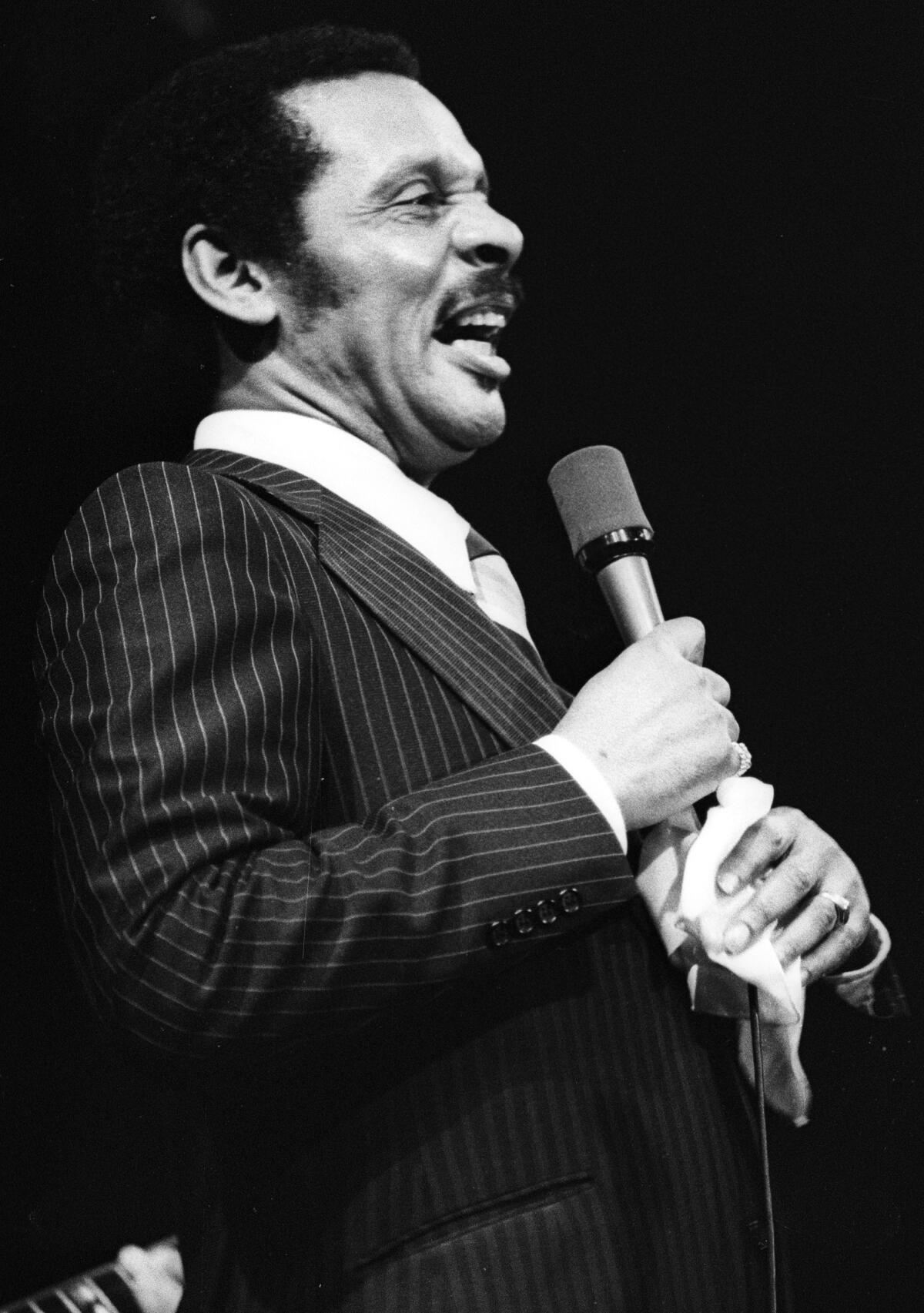Ernie Andrews, charismatic jazz singer and mainstay on the Central Avenue music scene, dies

- Share via
Few artists besides expert jazz and blues singer Ernie Andrews, who died Monday at 94, could claim to owe their big break to the iconic film star Betty Grable, and fewer still could boast that their music teacher was the famed New Orleans jazz trumpeter Bunk Johnson.
Those were two of many memorable moments that the casually assured, velvet-voiced singer Andrews experienced during a lifetime in music. His death was confirmed in a statement by his family. No cause was given.
“All I’ve ever known in life is singing. I just sing and sing and sing and sing,” Andrews said in “Blues for Central Avenue,” a 1986 documentary on the historic Los Angeles music district and his place in it.
Andrews, described as the “Crown Prince of the Blues” in one late-1940s newspaper ad, made his name starting in the post-WWII music clubs up and down Central Avenue that were filled with instrumentalists such as Charlie Parker, Charles Mingus, Eric Dolphy and Erroll Garner. In the bustling South Los Angeles community, the young singer began working to entertain legions of area jazz and R&B fans.
The vocalist was so in tune with the songwriting scene that by the time he was in his late teens he had connected with songwriter Joe Greene. Of one creative burst of genius, Andrews recalled telling Greene that he needed a quick-turnaround song for a recording session. Andrews said Greene “went home and wrote ‘Don’t Let the Sun Catch You Crying.’”
Andrews earned his most prominent platform after bandleader Harry James, then married to Andrews fan Grable, asked him to join the Harry James Orchestra in 1959. The singer accepted and for the next decade toured with the orchestra nationally and internationally. It was a musically conservative gig, however, that wasn’t especially suitable for Andrews’ ability to let loose with octave-spanning expressions of individuality.
“Ernie Andrews was one of the most versatile singers that I ever heard — and certainly ever worked with,” jazz guitarist Kenny Burrell said after learning of Andrews’ death.
Burrell, whose voluminous credits include backing luminaries such as James Brown, Billie Holiday and Aretha Franklin, said Andrews “could sing so many different things and do an excellent job on it. He could sing the blues. He could sing jazz. He could sing ballads and he could sing rhythm and blues.” Burrell and Andrews collaborated both in the studio and during club gigs on the L.A. jazz scene.
“I’ve been singing all my life,” Andrews told The Times’ Leonard Feather in a 1987 profile. The singer then added a succinct autobiography: “I was born on Christmas Day, 1927, in Philadelphia; my parents sang in the Baptist church. We moved to New Orleans, and in junior high I played the drums, studying music with the legendary trumpeter Bunk Johnson. I was baptized down in the bayou, in alligator-infested waters.”
By the time the family arrived in Los Angeles in 1945, Andrews was already well schooled in live performance. “We’d go to stage shows and there I saw all the greats: Ella Fitzgerald, Jimmie Lunceford, Earl Hines,” Andrews told The Times in 1994. “I saw so many shows that I knew I wanted to be a part of all that, but didn’t know how to do it.”
Settling in South Los Angeles, he enrolled at Jefferson High School, where he continued his music education. Andrews’ classmates included saxophonists Dexter Gordon and Sonny Criss. At night, he and his friends would hit Central and absorb jump-blues and bop at spots such as Downbeat, the Gayety Jungle Room and an upstairs club called Lovejoy’s.
After winning a talent contest, the singer released his first solo record — a 10-inch single — on a small Los Angeles label called G&G in 1945. Its A-side was a bawdy Greene-penned song called “Wrap It Up, Put It Away (Till Daddy Comes Home From the Army).” Its B-side, “Soothe Me,” soon became the singer’s calling card, and sold more than 300,000 copies.
Despite his distinctive delivery, Andrews never managed to make the lightning-in-a-bottle record to propel him into the big time.
Then again, by the mid-’50s, the timing wasn’t right for a versatile young jazz and blues singer looking for smash hits. “Rock ’n’ roll came, and then after that it was rhythm and blues,” Andrews said in “Blues for Central Avenue.” “I really tried to make a change — just to give it a shot. But it just didn’t feel right with me.”
The Central Avenue scene had seen better days by then. “There were police and some of the authorities didn’t like the idea of people — especially young white ladies — coming down and mingling in the clubs,” Andrews recalled. “When it started to fall, it fell real fast.”
By the end of the 1960s Andrews had released five solo or collaborative albums for labels including GNP and Dot. He teamed with Capitol Records’ in-house producer David Axelrod for two crate-digger-classic 45s, “Where Were You (When I Needed You)” and “Fine Young Girl.” Neither made a dent, and Andrews gradually moved away from a record business that never fully backed him. He earned his living in clubs, both onstage and behind the scenes.
Andrews was still in fine voice when, in the mid-1980s, bandleader Rickey Minor entered the scene, Minor told The Times after Andrews’ death was confirmed. While learning the ins and outs of the city’s jazz and session musician scenes, Minor was struck by Andrews’ skills and his presence. “When he walked in the room, he commanded your attention. He’d have his cap to the side, he might have had a cigarette in hand, and he would come in and just floor everyone with his singing.”
Andrews, added Minor, “understood not only the music he was singing but the story. He was a storyteller. He had you as soon as he started the first line. You’d go. ‘I need to hear the rest of this story.’” Minor noted that Andrews had high expectations of his backing players, and could be blunt in his criticism. “But by the end of the night, he would always pull me to the side and say, ‘You know, we’re hard on you because they’re not going to be light on you out there in the real world.’”
All told, Andrews released at least 19 solo and collaborative albums. That none entered the pantheon of classic recordings never sat well with Andrews, who nonetheless remained secure in his talent as a singer. But he didn’t blame anyone in particular for the lack of mainstream applause.
“I might be a little angry, but I don’t feel anyone did anything to me,” he said in the 1986 documentary. “Whatever happened to me I did it to myself. I allowed it, because I didn’t have the moxie, you understand?”
Burrell, who until recently had weekly conversations with Andrews, expressed frustration that “the critics didn’t recognize his greatness. It’s almost like it was too much for them to comprehend — whereas had he just been a blues singer or a jazz singer, it would have been simpler for them.”
That lack of attention, in fact, was expressed in a review of an Andrews set in 2000. “One could only wonder, given Andrews’ skills, why he has such a relatively low-visibility career,” wrote Times jazz critic Don Heckman. “Fortunately, at 72, he is still in full command of his abilities.”
Andrews was preceded in death by his wife of 52 years, Delores Benemie Andrews. He is survived by a daughter, Stephanie Andrews Williams; sons Dueal Ernie Andrews, Dana Andrews, Daryl Andrews and Mark Andrews; a companion of 22 years until her death in 2020, Miss Bernice Delany; 12 grandchildren; and 29 great-grandchildren and great-great-grandchildren.
“I’ve gotten the stigma of being arrogant and cocky, belligerent, over my days,” Andrews said of his approach to music. “But I just love to be free. I don’t owe nobody anything.”
More to Read
Updates
8:27 a.m. Feb. 28, 2022: This story has been updated to include more complete information on Andrews’ survivors.
The biggest entertainment stories
Get our big stories about Hollywood, film, television, music, arts, culture and more right in your inbox as soon as they publish.
You may occasionally receive promotional content from the Los Angeles Times.











